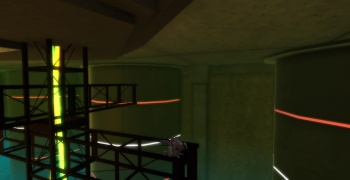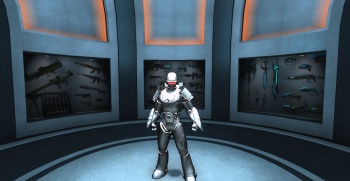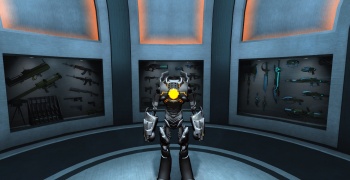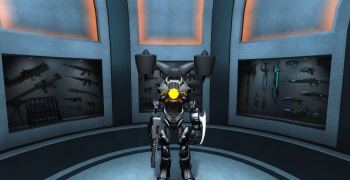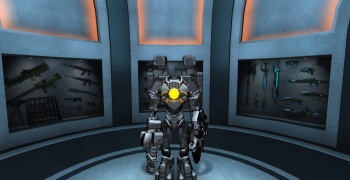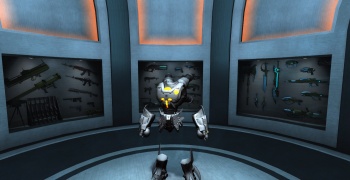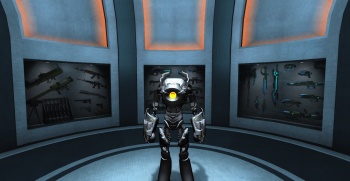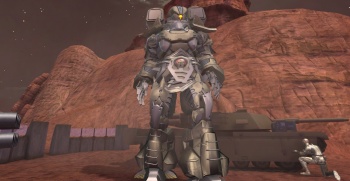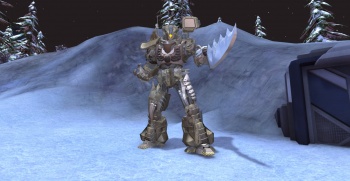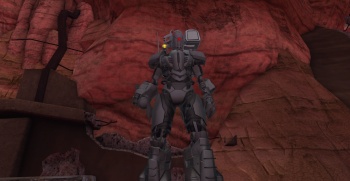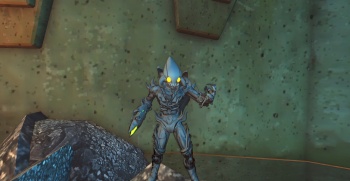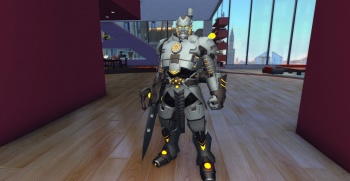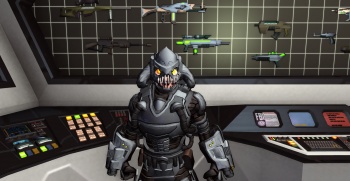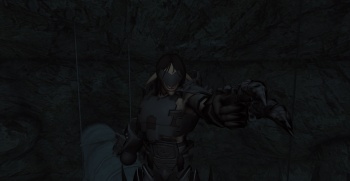Difference between revisions of "Ardacorp"
| Line 204: | Line 204: | ||
[[image:Screenshot 2015-06-17-13-48-18.jpg|350px|thumb|center|'''Subject-N13 as seen in full armour, along with an arm-mounted blade formed by 3GEN nanites'''<br>(Character made by @Absonus-Noctis)]] | [[image:Screenshot 2015-06-17-13-48-18.jpg|350px|thumb|center|'''Subject-N13 as seen in full armour, along with an arm-mounted blade formed by 3GEN nanites'''<br>(Character made by @Absonus-Noctis)]] | ||
| − | '''Subject-N13''' was the second chosen, and officially the first successful post-Crusader product to be born of the laboratories, due to Sheridan's cover-up. A severely deformed individual, 'Titan', as he likes to be known, was 'born' without arms, and required extensive cybernetic augmentation – including the need for limited life-sustaining enhancements due to malformed lungs; the result was an amalgamation of crimson flesh and metal, a hulking figure of over seven feet tall, Titan is a force to be reckoned with when it comes to brute strength – and he even has an admirable level of intellect to compliment it, avoiding the typical “all brawn and no brains” stereotype. The subject became a test unit for Ardacorp's '3GEN' nanites – tiny, bug-like robots with incredibly basic functions; they were programmed to scuttle along Titan's body, repairing any inflicted damage – even being able to recycle material from the armour that the creature wears into a wide range of weaponry, making N13 | + | '''Subject-N13''' was the second chosen, and officially the first successful post-Crusader product to be born of the laboratories, due to Sheridan's cover-up. A severely deformed individual, 'Titan', as he likes to be known, was 'born' without arms, and required extensive cybernetic augmentation – including the need for limited life-sustaining enhancements due to malformed lungs; the result was an amalgamation of crimson flesh and metal, a hulking figure of over seven feet tall, Titan is a force to be reckoned with when it comes to brute strength – and he even has an admirable level of intellect to compliment it, avoiding the typical “all brawn and no brains” stereotype. The subject became a test unit for Ardacorp's '3GEN' nanites – tiny, bug-like robots with incredibly basic functions; they were programmed to scuttle along Titan's body, repairing any inflicted damage – even being able to recycle material from the armour that the creature wears into a wide range of weaponry, making N13 a very diverse and adaptable fighter. |
[[image:Screenshot 2015-06-17-14-12-20.jpg|350px|thumb|center|'''Subject-N52 as seen in full armour''']] | [[image:Screenshot 2015-06-17-14-12-20.jpg|350px|thumb|center|'''Subject-N52 as seen in full armour''']] | ||
Revision as of 11:54, 27 June 2016
|
The author of this article has marked this as a creative work, and would prefer that other users not edit it. Please respect this, and unless repairing a typo, spelling, or other minor technical error, think of this page as read-only. |
Do you own a business or an institution that you feel needs protection? Are you responsible for the safe keeping of financial assets, government property, or sensitive materials? Then your solution is clear: Ardacorp. Originally a CCTV developer, we have been involved in the business of security since our foundation in 1984, and have progressed to providing additional means of protection; alarm systems, weaponised cameras, infrared laser tripwires, electroplate floor conversion, and optical camouflage sensors are just a few of the services we offer for one-time payments.
If you'd prefer something a little more mobile, or perhaps want to add something alongside your fixed defenses, we also offer self-guiding drones, as well as server installation for monthly fees; but if none of that takes your fancy, we can always throw a well-trained agent your way for varying monthly costs. Seen anything you like yet?
If the answer is yes, then head over to our website at www.ardacorp.com to browse our product line; alternatively, you may give us a call on 0196919840 and speak to a non-automated adviser (call costs vary with provider).
Do not delay – your security depends on it.
Contents
Overview
Ardacorp began as an automated security company, producing cameras and alarm systems for commercial, as well as private properties. Its CEO, Victor Ardaman, set up the company in 1984, based in North Carolina; Ardaman's business was pooling in a fair profit, largely because of his own obsession with cost efficiency - so large amounts of resources and time were spent in the research and development of materials to support this philosophy. The company evolved to producing cameras with built-in weapons systems after several years; these were purchased by other licensed businesses and property owners to protect high-priority buildings.
Staying true to its roots, Ardacorp stuck with the development of security cameras, but began moving in the direction of mobile systems: robots. Initially, it began with the company's first automated unit, known as the 'Incursion Drone'; They were small, quadruped mobile robots that housed many sensors within domes found at front of their bodies, in place of where a head would normally be found on a four-legged animal; they were based on the idea of a hive mind, all of the drones linked to one (or several) mainframes that ran specifically to keep them all online and issue necessary commands to the units; the mainframes were also built by Ardacorp, and installed into properties that requested an order (which could even be ONE) of drones. It was then that Ardaman came to a realisation; if he developed machines that could be used in place of human soldiers during times of conflict, he could both save lives and open up a whole new window of opportunity to his company... He now also intended to supply law enforcement and government military with weaponry and mechanical soldiers; Ardaman saw the implications of using people as soldiers -- the cost of supplying each individual with their own personal armament, as well as the cost and time of the training needed to create battle-ready troops.
Revealing to the American government the projects that Ardacorp had come to complete, Ardaman soon secured a deal to supply the military with a batch of thirty new "ICD" units...
Technological advancement
Ardacorp's robotic infantry were designed to be cost-effective. They needed to be able to act on their own, as well as use sturdy but fairly inexpensive materials. The result was the "ACRP-ICD-001", Ardacorp's first mechanised infantry unit. The name stood for "Intelligent Combat Droid"; it had a basic AI, controlled by a non-localised central mainframe, which would often be situated safely within a headquarters. The ICD ran with the concept of "quantity over quality", they were reknown for being cheap and easy to produce, but their programming often lead to confusion when in combat.
Limitations were a hurdle that Ardacorp sought to extinguish. The ICD's programming and processors needed to be upgraded; it took the company over 6 years to produce a new unit that was reliable enough to be used as conventional infantry. The ICD series ended with the Mk.4, which turned out to be too expensive to mass-produce.
The new unit that was chosen was the first in the ACRP-OSS series, or "Omega Super Soldier". It was a humanoid infantry unit that used kendrium armour plating with a cheaper titanium inner frame. It was durable, albeit more expensive than the original ICD; however, it proved to be a roaring success in action - able to take down at least four fully-trained men, on average, before their destruction.
The OSS Mk. 2
Since the closure of the ICD series, Ardacorp had moved forward in the field of robotics; introducing the OSS Mk. 2, a more effective but visually identical upgrade to its Mk. 1 predecessor. This unit became the basis of the company's humanoid drone units - the chassis being taken and re-purposed to yield another variant for a different job. This DRASTICALLY reduced production costs, also due to the fact that these new units have all their equipment stored within the torso - which doubles as the head; additional armouring was implemented around the torso area on this design, but the cost of the extra plating is dwarfed by the articulation systems that were present upon the ICD units, for connecting the head to the body. The standard OSS Mk. 2 model was replaced with the upgraded Mk. 3 on the 16th of December, 2014.
The aerial variant discarded the Mark 2's twin particle blasters in favor of an arm mounted auto-cannon and a mechanical hand with arm mounted kendrium-questionite close quarters blade. Two large turbine thrusters are present upon its back, allowing it sustained flight for long periods. The OSS Mk.2 Aerial was decommissioned on the 25th of December, 2014.
The Titan takes the standard Mark 2 chassis, bolsters it with additional reflective armour plating for deflecting laser-based attacks, swaps out both particle blasters for a 15mm Gatling gun and questionite shield, and adds on two missile pods onto its back. Surely a force to be reckoned with, the Titan is a walking tank in its own right. The OSS Mk. 2 Titan was decommissioned on the 20th of December, 2014.
Easily the comany's most expensive mass-produced unit, the "Maglev" is, as its name would suggest, a drone that utilises magnetic levitation. It resembles the OSS Mark 2 with regards to appearance, but it is in fact much different; because of its complex nature, the Maglev is required to have a more sophisticated AI, which in turn makes it more effective in combat. Because its body parts are separate from each other, it has an amazing ability to avoid enemy fire, tactically relocating its particle blasters to rain down destruction upon targets. The Maglev is the only OSS Mk. 2 variant that is still currently in service.
The OSS Mk. 3
The Mk. 3 OSS unit looks strikingly similar to its predecessor; the main difference can be seen on its torso section -- the body of the Mk. 2 was swapped out for a new design that allowed for more sophisticated optical equipment to be mounted; the chest is also deeper, coming out further than before due to a thick, armoured ring encircling the camera array entirely. Aside from that, upgraded hardware was installed inside the new chassis, including a more economical micro-filament generator - which became a widely used piece of technology within company products.
Manually Operated Units
Ardacorp might have began as an automated security firm, but Ardaman isn't one for limitations when it comes to profit; after all, he was already trying to crack open the military market, so manually operated products were surely something that needed to be considered; Sadly, at times, AIs and robots can become faulty -- piloted machines are considered to be safer, by some.
So, with heavy firepower seemingly in high demand, the company gave birth to the Comet. It was a towering, mechanized powerhouse, featuring a number of built-in weapons systems that gave it an unprecedented level of offense. The cockpit was found within the torso; an armoured hatch on the front of its body allowed entry to the pilot's seat -- digital displays linked up to the Comet's cyclopean optic, as well as cameras mounted on both arms, would be used instead of a conventional windshield or viewscreen; this gave the driver increased levels of protection, which made the Comet a favorable choice amongst Ardacorp's larger and more wealthy clientele. The Comet was the company's first batch-produced product. Over six-hundred are estimated to have been built.
In fact, the Comet was so popular, that second-hand units began to appear on the black market. The company's Monster Squad were dispatched to Alaska in order to eliminate a modified Comet unit, within the hands of armed Russian insurgents reported around Wainwright, to the North. Some of the unit's armour had been removed and replaced with white plating, a missile pod was missing, and its left arm was replaced with a reinforced steel blade; it was assumed that if the modified Comet were left unopposed, the insurgents would've completely re-armoured it, and possibly added additional weaponry.
After two years of the Mark 1 being in service, its successor emerged. Some parts from the original were used on the Mark 2, but its visual design was totally different. It had a lower overall weight, making it more mobile - despite this, its defenses were barely compromised; however, its range of weaponry was more limited, and it had no offensive systems stored inside its paneling; instead, it made use of a one-hundred-and-five millimeter cannon, mounted upon its right arm, along with a twenty-millimeter auto-gun alongside the 105's short barrel. On its left arm, it mounted Ardacorp's first energy efficient laser blade, which concentrated enough energy to slice through the majority of armour materials less than one-hundred-millimeters thick with barely any effort. The Mk. 2 discarded one of the original's missile pods in favor of additional sensory and communications equipment, as well as a spotlight.
The ABRAD absorption
Shortly after the OSS Mk. 1's introduction in 1995, Ardaman had considered an alternative to robotics which could possibly reduce production costs tenfold; they would attempt to create a biological soldier. The aim was to make them non-sentient, lacking any real human emotion aside from anger or, when necessary, fear. Only the most basic primal instincts were to be implemented within these soldiers. They wouldn't require armour, or weaponry; everything would be grown 'naturally', equaling more profit for Victor's company.
However, it wasn't Ardacorp that pursued this goal single-handed; they didn't have the resources, staff, or facilities to even begin work in this field - one they had no previous experience with; which is why Ardaman instead approached a string of stem cell research labs, known collectively as 'ABRAD' (American Biological Research and Development), buying out their sites and scientists in order to fulfill his wishes.
After eight years of research and development, Ardacorp managed to create the "Cerberus". This was to be known as the company's first biologically-engineered creature. It was large, standing at around 3 meters tall; it was a ferocious and largely feared unit, but it was too expensive and imperfect to mass-produce. The Cerberus took 2 years to fully mature, and only five were ever grown. The expense was due to the cybernetic implants needed to keep the creature alive; various life-sustaining pieces of equipment were necessary, or it would die. Ardacorp's newly-acquired bio-engineering labs were fairly sophisticated, but the professors and doctors involved in the project were still unable to yield a self-sustaining lifeform due to inexperience with growing man-made organisms.
Around six years later, the Crusader was born. This new unit stood as tall as 7ft, a bit bigger than the average man; it adopted a hunched posture, much like the Cerberus, but it was different; the Crusader made use of a biologically-engineered weapon, grown from its right arm. The weapon used a very simple concept: various specially-designed muscles were linked to a gland within the weapon. When fired, the muscles would spasm and force the corrosive biogel substance from the gland, and onto anyone unfortunate enough to be stood in the way. Unlike its predecessor, the Crusader was totally void of cybernetics; it was able to sustain itself without the need of machinery - they could live for a total of ten years.
It wasn't long before a number of factories were converted into laboratories for the mass-production of the Crusader. They were superior to any soldier because of their short maturation period; it took only two weeks from birth for a single Crusader to fully mature, ready for combat.
February 23rd 2008, United States Army audience
The following text is the written translation of an audio recording with Victor Ardaman, Ardacorp CEO, whilst attending a formal meeting arranged with the US Army:
Army Representative (AR): “Mister Ardaman, welcome.” AR rises from a chair placed behind a desk, extending their right arm towards Ardaman in offering of a handshake.
Victor Ardaman (VA): “Hello.” Ardaman takes AR's hand in his own and completes the handshake, before sitting down in the chair on the opposite side of the table to AR, who simultaneously sits in their own.
AR: “So, I understand that, after your last arrangement with us, things have changed?” AR leans on the table with both arms, intently awaiting VA's response.
VA: “W-Well; not quite.” VA pauses. “I actually came to ask a question – and discuss it, of course... I've had a...” VA once again pauses. “An idea, really.”.
AR: “An idea. I see; well, please go ahead.” AR gestures with a hand for VA to continue.
VA: “Putting Ardacorp's mechanised infantry aside... I was thinking; say... Theoretically... What if a soldier – that could outclass a human with regards to combat performance – was able to be grown, from scratch, and required no additional help.” VA pauses. “As in... Equipment. Guns, armour, anything.” VA pauses again, before raising a finger and stating: “Now that IS theoretical, of course...” VA appears to fidget.
AR: AR observes VA's body language for a moment, faintly raising an eyebrow before responding. “Alright... Well, that concept would be good if said 'soldier' could be grown in a reasonable amount of time.”, VA seems incredibly eager to answer.
VA: “I knew you'd say that – which is why I was-”, once again, VA pauses. “Nevermind; so... Within a reasonable amount of time. How does, say... Two weeks sound? Theoretically.” VA interlocks the fingers of his hands, leaning on the table with both elbows.
AR: “Your frequent use of 'theoretically' is a little unnecessary; you've already made it clear that it's a concept – and not a reality. Right?” AR tilts his head a little, with VA cutting in before AR can continue.
VA: “Absolutely – it's ludicrous to think of it were a reality.” VA chuckles, then shakes his head. “No, no – it's entirely theoretical.” VA blinks, perhaps realising his citing of 'theoretical'.
AR: AR pauses for a considerable time, watching VA. “Right... So – you're telling me that you've... 'Considered'...” AR appears to eye VA for a short time. “Growing soldiers for military use? And you're saying that you plan for them to only take two weeks growth time?”
VA: “Yes.”
AR: “So what will these soldiers be like, then?” AR once again raises an eyebrow, awaiting a response.
VA: “I should think they're a lot like animals.” VA pauses. “They'd BE a lot like animals, rather. They would have basic instincts – fear included; because it's rather a necessity for survival, is it not?” VA grins rather sheepishly. “But of course, it would take a bit to scare them – say... When a heavy loss is occurring. Anyway... They'd be grown with some sort of weapon already on them – a biological weapon; one that replenishes its own ammunition.”
AR: AR seems amused at the thought, shaking his head. “Mister Ardaman, are you aware of the implications of such an idea?”
VA: VA pauses for quite a while, an expression of bewilderment overcoming his face. “I...- What 'implications'? You mean-” AR cuts in.
AR: “I mean the fact that, as you said, they're animals. What if we needed to send them into a conflict where civilians are present? An occurrence like that happens quite a lot in this day and age. They'd be absolutely terrified of these...”, he pauses with a smirk, “Okay – they're practically monsters, from what you're suggesting. They'd be terrified of these monsters around them; and the United States Army does not terrorise civilians.” VA doesn't offer a reply, despite AR's pausing. AR continues: “Human soldiers can think properly, and don't rely solely on instinct to carry out a mission; they can communicate – and that's a very good point, actually; how will these things speak?”
VA: “No – you're right. It's a far-fetched idea.” VA shakes his head, with AR crossing their arms. “I'd just considered alternative ways of reducing military costs.”
AR: “And we'd be happy to accept your alternative ways, if they prove to be efficient.”
VA: VA looks at AR silently for a short while, seemingly deep in thought. VA eventually nods. “Thank you for your time – and I'm sorry if you feel it's been wasted.”, VA stands up, offering his right hand to AR for a handshake.
AR: “Not at all.”, AR stands up and completes the handshake, VA turning to leave shortly after.
The sound of a door can be heard closing in the background. AR addresses a colleague through the one-way glass allowing sight into the interview room:
AR: AR chuckles, knowing VA isn't in earshot. “Was he being completely serious? Growing monsters to replace soldiers – that's fucking ridiculous.”
The audio recording ends there.
The mass burning of March 12th
After the United States Army audience that Ardaman had arranged to discuss the 'concept' of his Crusader units, he was incredibly displeased with the response they gave. Considering the disapproval of the Army, and the units having no other real use aside from being terror weapons, the CEO ordered a mass burning of the creatures; a cruel, but necessary (he felt) solution to this new 'problem'; and so, on the 12th of March, 2008, Ardacorp staff gathered up the Crusaders into large pens, outside, not far from the company's outpost situated in Denver, torching the masses of monstrous products - much to the beast's dismay, bellowing out agonizing cries and terrifying screeches.
Some residents of Denver, present in the city at the time, reported to have smelt a strong barbecue scent.
Playing God
By 2008, Ardacorp's biological research and development department had garnered much experience from the Crusader project. However, because of the failed 'pitch' made by Ardaman, the company had to shift its focus a little, in search of a product with more intellect. Instead of creating organisms from scratch, they would begin to integrate alternative DNA into embryos, attempting to find the perfect recipe. Some of the scientists that Ardacorp had hired already experimented with Qularr subjects in the past, so this was a perfect starting point; using a small clutch of frozen Qularr embryos, which had been kept in preservation since early 1966, the company created five successful products that incorporated Qularr and human DNA. Four of the five subjects were given "meta genes" of varying type; cryokinesis, pryokinesis, electrokinesis and gyrokinesis. The fifth subject was not given meta genes.
In order to speed things up, the successful subjects were suspended within gel-filled tanks. The substance inside the tanks was actually a healing bio-gel, which happened to be a byproduct from the Crusader project - but this time, it was being used as a catalyst for the growth of the subjects. By the end of the year, they were all fully grown, and had attained the biological age of thirty. Artificial memories were implanted into their brains. Unfortunately, the electrokinetic embryo had developed incorrectly, and was missing both of its arms; this problem was remedied through the use of cybernetic augmentation.
Despite all of the work that was put into the creation of these Qularr-human subjects, a terrible incident involving the Qularr invasion of 2009 had lead to the escape of the four meta subjects, as well another unrelated experiment which had claimed to be their brother prior to its departure. Suffering from high levels of stress and emotional trauma because of the Beacons, the subjects used their abilities to wreak havoc within the facility, causing the deaths of several scientists and responding security personnel, in order to free themselves from the lab. The non-meta subject was left behind, in company hands. This was an incredibly detrimental event for Ardacorp; not only had their facility been heavily damaged and employees killed, but their newest successful subjects which were intended for transfer into the Monster Squad programme had also gotten loose.
A Slight Problem...
Because of the nature of Ardaman's business, his privacy was routinely interrupted by superheroes to check up on the company and which direction it was headed. Needless to say that Ardacorp's biological experiments and genetically-engineered creatures would raise various ethical issues. Not only this, but the company became the target of the infamous supervillain, Warlord. He was interested in Ardacorp's technology, and sought to take it by force; most of the time, succeeding. Ardaman simply couldn't allow this, and the authorities weren't enough; he figured that taking the matter into his own hands was the best course of action.
The year 2011 was when Ardacorp changed its ways. Its CEO had deemed the company too vulnerable; so he began sending unmarked, newly-produced and unregistered units to attack numerous superheroes with publicly-known identities. The same was done with supervillains. The attacks seemed indiscriminate; had Ardaman gone mad? It was rather simple... By removing a large number of super-powered individuals, Ardacorp would be able to effectively operate in the open with very little disruption.
This would likely be Ardaman's biggest mistake.
The Monster Squad
The Monster Squad is an elite fighting unit formed upon CEO Victor Ardaman's request after a formal meeting with his team of biologists – ex-ABRAD scientists, formerly devoted to the practice of stem cell research. The Crusader project blossomed; it was the cause of additional breakthroughs (such as the creation of a healing bio-gel), and provided the company with a formidable soldier... But the Crusaders themselves didn't quite cut it. The company needed something more intelligent. The Monster Squad was the answer.
The unit was to be composed only of the most successful products from previous genetic experiments – the wheat among the chaff. Many were malformed fetuses or, more commonly, lumps of basic living matter with no proper function or use – but those chosen for the Squad were marvels of the (un)natural world, sporting intellect, strength, or agility that far and away surpassed their Crusader brothers. It was no longer about building an army, but about assembling a compact force that could topple an army.
The first chosen for the unit – a woman known only as Sheridan – was seemingly just your standard human female. Her outward appearance didn't make her seem all that special; but that was the point... Sheridan was, you see, the perfect infiltration agent – a shape-changer. Born of the same string of experiments that followed the Crusader project, she was the first to steal the spotlight. With the ability to shift individual cells around her body, rapidly grow more, and even change her skin's complexion, she was a creature of no gender – but chose to identify, and adopt the appearance of, a female; typically perceived as the more innocent and harmless gender. Only those within the highest seats of the Ardacorp company know of her true nature – and Ardaman gave her the authority to oversee future genetic research and development, covering up what she really was by introducing her as a new employee and leading geneticist...
Subject-N13 was the second chosen, and officially the first successful post-Crusader product to be born of the laboratories, due to Sheridan's cover-up. A severely deformed individual, 'Titan', as he likes to be known, was 'born' without arms, and required extensive cybernetic augmentation – including the need for limited life-sustaining enhancements due to malformed lungs; the result was an amalgamation of crimson flesh and metal, a hulking figure of over seven feet tall, Titan is a force to be reckoned with when it comes to brute strength – and he even has an admirable level of intellect to compliment it, avoiding the typical “all brawn and no brains” stereotype. The subject became a test unit for Ardacorp's '3GEN' nanites – tiny, bug-like robots with incredibly basic functions; they were programmed to scuttle along Titan's body, repairing any inflicted damage – even being able to recycle material from the armour that the creature wears into a wide range of weaponry, making N13 a very diverse and adaptable fighter.
Subject-N52 was the third. Claiming the title of 'Hunter', N52 was intended to be the leading figure and front-line commander for the Crusader legions, adopting some similar physical features – such as the long, exclusively canine teeth and muscular tail; the main difference was that he looked more... Human. He stood at slightly above average height, sharing the pinkish complexion of Caucasian skin, but the monstrous head, teeth and tail betray any claim to humanity. Unlike previous products, Hunter formed perfectly throughout his growth phase, requiring no mechanical aid to support life; it was widely regarded as the perfect life-form, strong and dexterous with keen senses and a, funnily enough, hunter's instinct. To further enhance these qualities, Ardacorp built and issued a powered exo-armour to the creature, covering its muscular body with protective metals and flexible arti-muscle, its physical qualities were made as outstanding as possible. On top of this, the exo-armour incorporates the use of two forearm-mounted chemical jet launchers, loaded with the hazardous 'Andronite' chemical – a creation by one 'Sicilia Andronius', an Italian chemist. With adhesive properties, and the corrosive power to eat through armour plating, these two weapon modules gave the monstrous humanoid a new level of offense. If that wasn't enough, the gauntlets of the exo-armour come equipped with location beacons, allowing two repeating particle blasters to be teleported directly into their palms when the situation demands for a more 'automatic' approach.
Subject-N76 was the fourth to be chosen. As far as the Monster Squad's members go, N76 – or 'Reaper' – is by far the strangest. Likened to Titan with respect to abnormal growth, Reaper was 'born' without legs and without a right arm – easily the most malformed of any 'successful' product; but Reaper has a heart and willpower strong enough to compensate for his physical setbacks. Like Titan, Reaper was enhanced with cybernetics, being given a set of expensive reverse-jointed mechanical legs, and a right arm limb replacement – effectively an articulated auto-gun; it served no other purpose besides literally shredding the life out of anyone, or anything, unfortunate enough to be on the company's hit list. N76 did, however, have a fully functioning set of organs within his perfectly-formed torso, and his left arm seemed fine; his face, however... His face was something else. The most prominent feature of the creature's mug was easily the large grin he permanently wore, his teeth shown in their full glory within a beaming smile that stretched from ear to ear. But it wasn't a happy one; on the contrary, Reaper was incredibly envious of the more 'perfect' subjects – even Titan, despite his physical abnormalities; Reaper had more, and he hated it. Despite this, he hides his feelings behind a veil of twisted humour, allowing his victims to be the ones to bare his bottled-up emotions – usually resulting in their dismembering, unfortunately. That's usually why N76 isn't called out to capture targets, or go on stealth missions.
“Do not be frightened by the things I may say! You can scream, and whimper, and pray all day, but your fate – as it stands – has been foreseen! Embrace the Reaper, for he is here – ready to make just one thing clear: death is inevitable, and you cannot hide; not even the gods will take your side! I shall rip, and shred, and tear, and rend, and you shall never see the end! Your life cut short at the tips of my rounds – your agonising pleas, such beautiful sounds! My claw craves blood, and yours would be great; stop writhing around and accept your fate...”
Staff Roster
Like all businesses, small or large, Ardacorp has many employees that all contribute towards the company in one way or another. This section displays important or notable members of staff.
The CEO
Victor Ardaman
Administrators and Operators
Harry Saunders
Engineers and Mechanics
Alexander Suffolk
Jovan "Achilles" Pasic
Scientists
Maria "Lucidia" Hewert
Sicilia Andronius
Shelly "Sheridan" Lawrence
Researchers
Adrian Breets
Security Agents
Stefan "Iron Sight" Musat
Elizabeth "Regina" Hall
Alice "Wraith" Morris
James "Ocular" Morris
Katia Winnock
Test Pilots
James "Goat" Vitson


